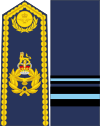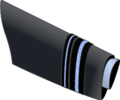Air vice-marshal (Air Vce Mshl or AVM) is a air officer rank used by some air forces, with origins from the Royal Air Force.[1] The rank is also used by the air forces of many countries which have historical British influence and it is sometimes used as the English translation of an equivalent rank in countries which have a non-English air force-specific rank structure.
Air vice-marshal is usually equivalent to a rear admiral or a major general. The rank of Air Vice-Marshal is immediately senior to the rank Air Commodore and immediately subordinate to the rank of Air Marshal. Since before the Second World War it has been common for air officers commanding RAF groups to hold the rank of Air Vice-Marshal. In small air forces such as the Royal New Zealand Air Force and the Ghana Air Force, the head of the air force holds the rank of Air Vice-Marshal.
The equivalent rank in the Women's Auxiliary Air Force, Women's Auxiliary Australian Air Force,[2] Women's Royal Air Force (until 1968) and Princess Mary's Royal Air Force Nursing Service (until 1980) was "air chief commandant".
Australia
The Australian Air Corps adopted the RAF rank system on 9 November 1920 and this usage was continued by its successor, the Royal Australian Air Force. However, the rank of air vice-marshal was not used by the Australian Armed Forces until 1935 when Richard Williams, the Australian Chief of the Air Staff, was promoted. Margaret Staib of the Royal Australian Air Force served in the rank of air vice-marshal from 2009 to 2012 when she retired from the Australian Defence Force.
Canada
In 1920, Sir Willoughby Gwatkin, the former Canadian Chief of the General Staff, was granted the rank of air vice-marshal and appointed the inspector-general of the newly established Canadian Air Force.[3] The rank was used until the 1968 unification of the Canadian Forces, when army-type rank titles were adopted. Canadian air vice-marshals then became major-generals. In official Canadian French usage, the rank title was vice-maréchal de l'air.[4]
India
United Kingdom
| Air Vice-Marshal | |
|---|---|
 Command flag | |
 Shoulder and sleeve insignia | |
 An RAF Air Vice-Marshal star plate | |
| Country |  United Kingdom United Kingdom |
| Service branch |  Royal Air Force Royal Air Force |
| Abbreviation | AVM / Air Vce Mshl |
| Rank | Two-star |
| NATO rank code | OF-7 |
| Non-NATO rank | O-8 |
| Formation | 1 August 1919 |
| Next higher rank | Air Marshal |
| Next lower rank | Air Commodore |
| Equivalent ranks | |
Origins
On 1 April 1918, the newly created RAF adopted its officer rank titles from the British Army, with officers at what is now air vice-marshal level holding the rank of major-general. In response to the proposal that the RAF should use its own rank titles, it was suggested that the RAF might use the Royal Navy's officer ranks, with the word "air" inserted before the naval rank title. For example, the rank that later became air vice-marshal would have been air rear-admiral. The Admiralty objected to any use of their rank titles, including this modified form, and so an alternative proposal was put forward: air officer ranks would be based on the term "ardian", which was derived from a combination of the Gaelic words for "chief" (ard) and "bird" (eun), with the term "third ardian" or "squadron ardian" being used for the equivalent to rear admiral and major general. However, air vice-marshal was preferred and was adopted in August 1919.[5] The following officers were the first to be appointed to the rank, and their former service ranks are also shown:
| Officer | Rank in RAF | Rank in Army | Rank in Navy |
|---|---|---|---|
| Edward Ashmore[6] | Major-general | Major-general | None |
| Sir Sefton Brancker[7] | Major-general | Major-general | None |
| Edward Ellington[8] | Major-general | Brigadier-general | None |
| John Higgins[9] | Major-general | Brigadier-general | None |
| Sir Godfrey Paine[10] | Major-general | None | Rear-admiral |
| Sir Geoffrey Salmond[11] | Major-general | Major-general | None |
| Sir John Salmond[12] | Major-general | Major-general | None |
| Sir Frederick Sykes[13] | Major-general | Major-general | Wing captain |
| Sir Hugh Trenchard[14] | Major-general | Major-general | None |
RAF insignia, command flag and star plate
The rank insignia consists of a narrow light blue band (on a slightly wider black band) over a light blue band on a broad black band. This is worn on both the lower sleeves of the dress uniform or on the shoulders of the flying suit or working uniform.
The command flag of an air vice-marshal has two narrow red bands running through the centre.
The vehicle star plate for an air vice-marshal depicts two white stars (air vice-marshal is a two-star rank) on an air force blue background.
- An RAF air vice-marshal's sleeve mess insignia
- An RAF air vice-marshal's shoulder board
- An RAF air vice-marshal's sleeve on No. 1 service dress uniform
- An RAF air vice-marshal's star plate
As of August 2014[update], air vice-marshal was the highest uniformed military rank currently held by a woman in the British Armed Forces when Air Vice-Marshal Elaine West was awarded the position in August 2013.[15]
Gallery
See also
References
...












